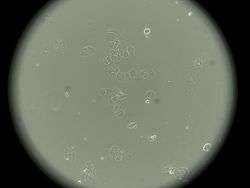MCF-7

MCF-7 is a breast cancer cell line isolated in 1970 from a 69-year-old Caucasian woman. MCF-7 is the acronym of Michigan Cancer Foundation-7, referring to the institute in Detroit where the cell line was established in 1973 by Herbert Soule and co-workers.[1] The Michigan Cancer Foundation is now known as the Barbara Ann Karmanos Cancer Institute.[2]
Prior to MCF-7, it was not possible for cancer researchers to obtain a mammary cell line that was capable of living longer than a few months.[3]
The patient, Frances Mallon died in 1970. Her cells were the source of much of current knowledge about breast cancer.[1][4] At the time of sampling, she was a nun in the convent of Immaculate Heart of Mary in Monroe, Michigan under the name of Sister Catherine Frances.
MCF-7 and two other breast cancer cell lines, named T-47D and MDA-MB-231, account for more than two-thirds of all abstracts reporting studies on mentioned breast cancer cell lines, as concluded from a Medline-based survey.[5]
Characteristics of MCF-7 cells
The characteristics of MCF-7 cells are:[1][4][5][6][7][8]
- Primary tumor: invasive breast ductal carcinoma
- Origin of cells: pleural effusion
- Presence of estrogen receptors: yes
- Proliferative response to estrogens: yes
- Presence of progesterone receptors: yes
- ERBB2 gene amplification (with Her2/neu protein overexpression): no
- Tumorigenicity in mice: yes, but only with estrogen supplementation
- Phenotype: luminal epithelial
This cell line retained several characteristics of differentiated mammary epithelium, including the ability to process estradiol via cytoplasmic estrogen receptors and the capability of forming domes.
Tumor necrosis factor alpha (TNF alpha) inhibits the growth of MCF-7 breast cancer cells. Treatment with anti-estrogens can modulate the secretion of insulin-like growth factor binding proteins.
PIK3CA helical mutations were identified in MCF-7, but with low AKT activation.[9]
References
- 1 2 3 Soule, HD; Vazquez J; Long A; Albert S; Brennan M. (1973). "A human cell line from a pleural effusion derived from a breast carcinoma". Journal of the National Cancer Institute. 51 (5): 1409–1416. PMID 4357757.
- ↑ http://www.cancer.gov Retrieved on 2010-04-28
- ↑ Glodek, Cass, Ph.D., "A History of the Michigan Cancer Foundation, the Beginnings & Growth of Detroit's Anticancer Movement," 1990, page 68, Michigan Cancer Foundation, Detroit.
- 1 2 Levenson, AS; Jordan VC. (1997). "MCF-7: the first hormone-responsive breast cancer cell line". Cancer Research. 57 (15): 3071–3078. PMID 9242427.
- 1 2 Lacroix, M; Leclercq G. (2004). "Relevance of breast cancer cell lines as models for breast tumours: an update". Breast Research and Treatment. 83 (3): 249–289. doi:10.1023/B:BREA.0000014042.54925.cc. PMID 14758095.
- ↑ Ross, DT; Perou CM. (2001). "A comparison of gene expression signatures from breast tumors and breast tissue derived cell lines". Diseases Markers. 17 (2): 99–109. doi:10.1155/2001/850531. PMID 11673656.
- ↑ Charafe-Jauffret, E; Ginestier C; Monville F; Finetti P; Adelaide J; Cervera N; Fekairi S; Xerri L; Jacquemier J; Birnbaum D; Bertucci F. (2006). "Gene expression profiling of breast cell lines identifies potential new basal markers". Oncogene. 25 (15): 2273–2284. doi:10.1038/sj.onc.1209254. PMID 16288205.
- ↑ Lacroix, M; Toillon RA; Leclercq G. (2006). "p53 and breast cancer, an update". Endocrine-Related Cancer. Bioscientifica. 13 (2): 293–325. doi:10.1677/erc.1.01172. PMID 16728565.
- ↑ COSMIC: Catalogue of Somatic Mutations in Cancer
External links
| Wikimedia Commons has media related to MCF-7 cells. |
- The University of Texas MD Anderson Breast Cancer Cell Line Data Base
- Barbara Ann Karmanos Cancer Institute Web site
- Cellosaurus entry for MCF-7